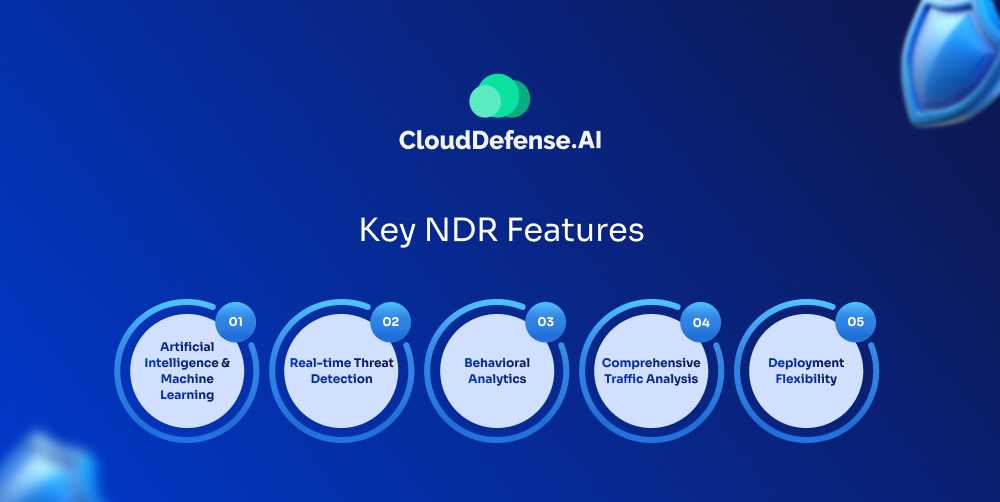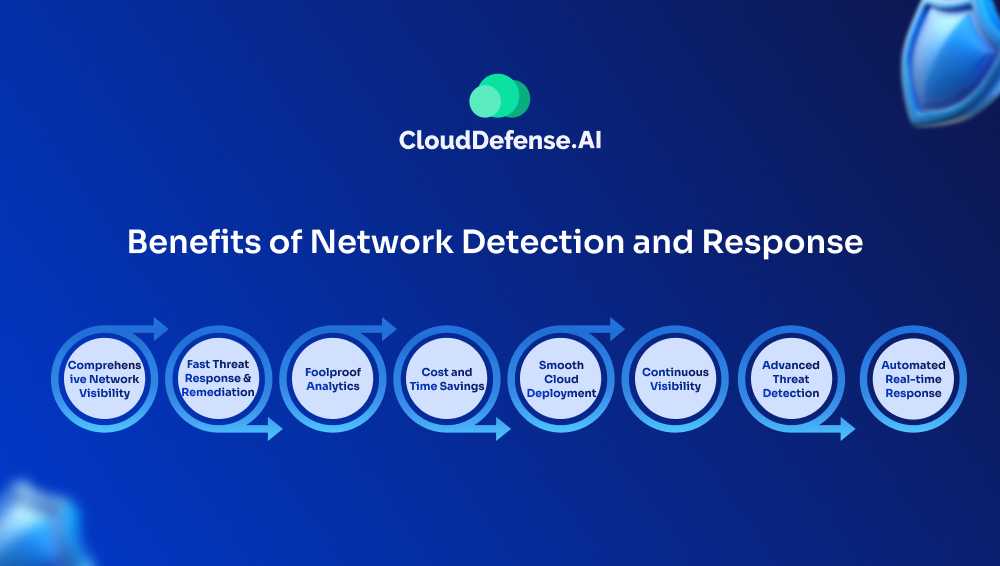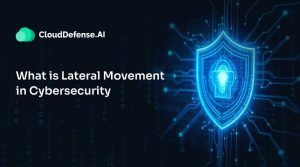What is Network Detection and Response?
Network Detection and Response, or NDR, refers to cybersecurity technologies that use AI, machine learning, and behavioral analytics to monitor and analyze network traffic for detecting, investigating, and responding to threats in real-time.
NDR examines both internal and external traffic, identifying abnormal activities that may indicate malware, targeted attacks, insider threats, or risky behaviors. Deployed through hardware, software, or SaaS, NDR enhances traditional defenses by providing comprehensive visibility and automated responses to evolving cyber threats.
How does Network Detection and Response work?
Network Detection and Response works by using machine learning and non-signature-based analytics to monitor and analyze network traffic, establishing a baseline for normal behavior. It detects deviations from this baseline, identifying potential threats. NDR solutions provide insights beyond firewalls by detecting lateral movements within the network that firewalls and endpoint security might miss.
Advanced Network Detection and Response solutions use AI and ML tools to model adversary tactics as per the MITRE ATT&CK framework, ensuring high-precision detection of attacker behaviors. They correlate events across users, applications, and time, streamlining security investigations. NDR also integrates with SIEM and SOAR systems, enabling real-time threat response and comprehensive security assessments.
Key NDR Features

Here are some key features that you need to keep an eye out for when it comes to choosing a Network Detection and Response solution:
Artificial Intelligence and Machine Learning
NDR solutions use AI and ML to assess network behavior and build models based on typical activity patterns. These models help in detecting deviations that may signify malicious activities.
Real-time Threat Detection
The use of advanced data analytics allows NDR to identify threats in real time, providing timely notifications and enabling swift responses.
Behavioral Analytics
By establishing a baseline of normal network behavior, NDR can spot anomalies that may indicate malware, targeted attacks, insider threats, or risky behaviors.
Comprehensive Traffic Analysis
Network Detection and Response examines both north-south traffic (between internal networks and public networks) and east-west traffic (within internal networks). This dual approach helps in detecting lateral movements of attackers within the network and external threats.
Deployment Flexibility
Network Detection and Response solutions can be deployed through various means including hardware appliances, on-premises software, and Software as a Service, catering to different organizational needs and infrastructures.
What Types of Threats Do Network Detection and Response Solutions Uncover?
NDR can identify a wide variety of threats. We have listed a good number of them below together with an overview of how NDR helps you in tackling them.
| Threat | Overview |
| Unmanaged IoT and OT | NDR identifies suspicious activities and vulnerabilities in IoT and OT devices that are often overlooked by traditional security measures. |
| Unknown or Unidentified Network Systems | It detects and monitors unknown or unidentified devices and systems connected to the network, ensuring no unauthorized access. |
| Insider Threats | NDR solutions can spot unusual behavior patterns among internal users, identifying potential insider threats from employees or other insiders. |
| Lateral Movement | They detect lateral movements of attackers within the network, identifying attempts to move from one system to another to escalate privileges or access sensitive data. |
| Command-and-Control Activity | NDR solutions monitor for signs of Command-and-control activity, where attackers communicate with compromised systems to control malware and extract data. |
| Malicious Network Traffic Flows and Patterns | They analyze network traffic to identify patterns that indicate malicious activities, such as abnormal data transfers or communication attempts. |
| Malware | NDR identifies and issues alert on malware infections by detecting unusual behaviors and traffic associated with known and unknown malware. |
| Ransomware | It detects the early signs of ransomware attacks, such as unusual file encryption activities and data exfiltration attempts. |
| Brute Force Attacks | NDR monitors for repeated login attempts and other indicators of brute force attacks aiming to crack passwords and gain unauthorized access. |
| Social Engineering | It can identify the signs of social engineering attacks, such as phishing attempts, by monitoring network traffic and user behavior for anomalies. |
| Data Theft and Manipulation | NDR detects unauthorized data access, exfiltration, and manipulation, protecting sensitive information from being stolen or altered. |
| Risky Behaviors | It identifies risky behaviors such as providing remote access to endpoints or sharing user accounts, which can compromise network security. |
Why is Network Detection and Response Important?
NDR is one of the many essential weapons of modern cybersecurity, providing advanced threat detection and real-time response capabilities. By continuously monitoring network traffic and using Artificial Intelligence and machine learning, NDR identifies and minimizes sophisticated attacks, including malware, ransomware, and insider threats.
It enhances visibility across all devices and systems, detects anomalous behaviors, and offers automated responses, significantly improving security operations. NDR is essential for protecting sensitive data, preventing lateral movement of threats, and ensuring comprehensive network security, making it a vital tool in defending against evolving cyber threats.
Benefits of Network Detection and Response

NDR offers numerous benefits, enhancing cybersecurity through visibility, rapid threat detection, and advanced analytics. Let’s check out some of these benefits below.
Comprehensive Network Visibility
NDR provides full visibility into all network activities, allowing organizations to understand cybercriminal tactics, techniques, and procedures. This insight helps in effectively protecting against future attacks.
Fast Threat Response and Remediation
NDR solutions detect network attacks in their early stages, providing immediate insights and enabling rapid response to stop attacks before they cause harm.
Foolproof Analytics
NDR analyzes network packets to assess user and device behaviors, establishing a baseline to detect anomalies. This approach provides a reliable source of truth, as network data cannot be tampered with or deleted.
Cost and Time Savings
NDR solutions require minimal configuration and can parse and store network data out of the box, reducing the need for extensive log management and saving time and money.
Smooth Cloud Deployment
Many NDR solutions are cloud-based, eliminating the need for on-premises log servers and simplifying the collection and analysis of network data.
Continuous Visibility
NDR ensures continuous monitoring across all network-connected users, devices, and technologies, including data centers, cloud environments, and IoT devices.
Advanced Threat Detection
Using behavioral analytics and AI, NDR solutions detect advanced and persistent threats with high precision, avoiding low-fidelity alerts and covering multiple phases of an attack lifecycle.
Automated Real-time Response
NDR solutions can automatically respond to and shut down attacks in real time, integrating with other cybersecurity tools like EDR and SOAR to enhance overall security posture.
Network Detection and Response Challenges
Implementing and managing NDR solutions comes with several challenges. The changing threat domain means that cybercriminals are continuously developing new tactics, techniques, and procedures to infiltrate networks, requiring NDR solutions to constantly adapt and update to stay effective.
The expanding digital environment also increases the attack surface, providing more opportunities for cybercriminals to exploit vulnerabilities. This requires strong and comprehensive monitoring, which can be difficult to achieve with NDR tools alone.
The cybersecurity skills gap further complicates the implementation and management of NDR solutions. A shortage of skilled professionals makes it challenging to deploy, configure, and maintain these systems effectively.
Additionally, budget restrictions pose a significant obstacle for many organizations. The costs associated with integrating NDR solutions into day-to-day operations, along with ongoing maintenance and updates, can be prohibitive, limiting the ability of some organizations to fully use the benefits of NDR.
Final Words
NDR complements EDR, SIEM, and IDS by filling coverage gaps, continuously monitoring network traffic, and providing packet-level context. Unlike EDR, NDR doesn’t require agents, making it effective for unmanaged devices like IoT. Due to its reliance on logs, which attackers can manipulate, NDR also offers deeper insights that SIEM lacks. By detecting threats that bypass firewalls and legacy IDS, NDR enhances overall cybersecurity by ensuring comprehensive visibility and actionable insights.







